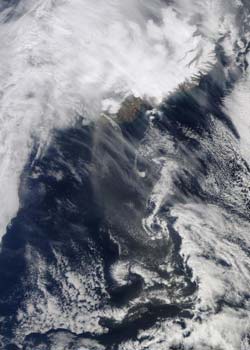NASA's Terra satellite keeps eye on Eyjafjallajökull's ash plume

The MODIS instrument on NASA\'s Terra satellite captured a visible image of the ash plume (brown) drifting south and east from Eyjafjallajökull volcano in Iceland at 11:55 UTC (7:55 a.m. EDT). Credit: NASA\'s MODIS Rapid Response Team<br>
The Moderate Resolution Imaging Spectroradiometer (MODIS) instrument on NASA's Terra satellite captured visible image of the ash plume (consisting of fine particles of pulverized rock) at 11:55 UTC (7:55 a.m. EDT). The plume appeared to be lighter in color than the previous few days, and it was drifting south and east over the Northern Atlantic Ocean.
NASA works with other agencies on using satellite observations to aid in the detection and monitoring of aviation hazards caused by volcanic ash. For more on this NASA program, visit:
http://science.larc.nasa.gov/
asap/research-ash.html
The MODIS Rapid Response System was developed to provide daily satellite images of the Earth's landmasses in near real time. The MODIS Rapid Response Team that generates the images is located at NASA's Goddard Space Flight Center in Greenbelt, Md.
Media Contact
More Information:
http://www.nasa.govAll latest news from the category: Earth Sciences
Earth Sciences (also referred to as Geosciences), which deals with basic issues surrounding our planet, plays a vital role in the area of energy and raw materials supply.
Earth Sciences comprises subjects such as geology, geography, geological informatics, paleontology, mineralogy, petrography, crystallography, geophysics, geodesy, glaciology, cartography, photogrammetry, meteorology and seismology, early-warning systems, earthquake research and polar research.
Newest articles

Combatting disruptive ‘noise’ in quantum communication
In a significant milestone for quantum communication technology, an experiment has demonstrated how networks can be leveraged to combat disruptive ‘noise’ in quantum communications. The international effort led by researchers…

Stretchable quantum dot display
Intrinsically stretchable quantum dot-based light-emitting diodes achieved record-breaking performance. A team of South Korean scientists led by Professor KIM Dae-Hyeong of the Center for Nanoparticle Research within the Institute for…

Internet can achieve quantum speed with light saved as sound
Researchers at the University of Copenhagen’s Niels Bohr Institute have developed a new way to create quantum memory: A small drum can store data sent with light in its sonic…




















